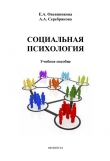
Текст книги "Социальное влияние"
Автор книги: Филип Зимбардо
Соавторы: Майкл Ляйппе
Жанр:
Психология
сообщить о нарушении
Текущая страница: 50 (всего у книги 51 страниц)
Mooney, H., Bradbury, C, and Folmer, K. (1990). The efficacy of four persuasion techniques in four conceptually different situations. Paper presented at the meeting of the Western Psychological Association, Los Angeles, CA.
Moore, Т. Е. (1982). Subliminal advertising: What you see is what you get. Journal of Marketing, 46, 38–47.
Moreland, R. L„and Zajonc, R. B. (1979). Exposure effects may not depend on stimulus recognition. Journal of Personality and Social Psychology, 37, 1085–1089.
Moriarty, T. (1975). Crime, commitment and the responsive bystander: Two field experiments. Journal of Personality and Social Psychology 31,370–376.
Morley, D. D. (1987). Subjective message constructs: A theory of persuasion. Communication Monographs, 54, 183–203.
Mosbach, P., and Leventhal, H. (1988). Peer group identification and smoking: Implications for intervention. Journal of Abnormal Psychology, 97, 238–245.
Moscovici, S. (1976). Social influence and social change. London: Academic Press.
Moscovici, S. (1980). Toward a theory of conversion behavior. In L. Berkowitz (Ed.), Advances in experimental social psychology (vol. 13, pp. 209–239). New York: Academic Press.
Moscovici, S., and Zavalloni, M.(1969). The group as a polarizer of attitudes. Journal of Personality and Social Psychology, 12, 125–135.
Mowen, J. C., and Cialdini, R. B. (1980). On implementing the door – in – the – Гасе compliance technique in a business context. Journal of Marketing Research, 17,253–258.
Mulbar, H. (1951). Interrogation. Springfield, IL: Thomas.
Mullen, В., Futrell, D., Stairs, D., Tice, D.M., Baumeister, R. F., Dawson, К. Е., Rior – dan.C.A., Radlojf.C.E., Goethals, G. R., Kennedy, J. G., and Rosenfeld,P. (1986). Newscasters' facial expressions and voting behavior of viewers: Can a smile elect a president? Journal of Personality and Social Psychology, 51,291–295.
Myers, D.G., and Kaplan, M.F. (1976). Group – induced polarization in simulated juries. Personality and Social Psychology Bulletin, 2, 63–66.
Myers, D.G., and Lamm, H. (1975). The group polarization phenomenon. Psychological Bulletin, 83, 602–627.
Neil v. Biggers, 409 U.S. 188 (1972).
Nelson, Z. P., and Mowry, D. D. (1976). Contracting in crisis intervention. Community Mental Health Journal, 12, 37–A3.
Nemeth, С J. (1986). Differential contributions of majority and minority influence. Psychological Review, 93, 23–32.
Nemeth, C. I., Mayseless, O., Sherman,]., and Brown, Y. (1990). Exposure to dissent and recall of information. Journal of Personality and Social Psychology, 58, 429–437.
Newcomb, Т. М. (1961). The acquaintance process. New York: Holt, Rinehart & Winston.
The New York Times (1990). U.S. tobacco ads in Asia faulted. P. J. Hilts (writer). May 5, p. 19.
The New York Times (1990). Killings in '89 set a record in New York. J. С McKinley (writer). Mar. 31.L27, L30. Newsday (1990). Mar. 28. News – week (1990). Feb. 5.
Nisbett, R.E., and Ross, L. (1980). Human inference: Strategies and shortcomings of social judgment. Englewood Cliffs, NJ: Prentice – Hall.
Nisbett, R. E., and Schachter, S. (1966). Cognitive manipulation of pain. Journal of Experimental Social Psychology, 2, 227–236.
Nisbett,R.E., and Wilson,Т.О. (1977a). Telling more than we can know: Verbal reports on mental processes. Psychological Review, 84, 231–259.
Nisbett, R. E., and Wilson, T. D, (1977b). The halo effect: Evidence for unconscious alteration of judgments. Journal of Personality and Social Psychology, 35, 250–256.
Nix, S. (1989). Weekend with the Moonies. San Francisco Chronicle, Aug. 10, Bl, ВЗ, В6.
Nizer, L. (1961). My life in court. New York: Pyramid.
Nord, W. (1970). Improving attendance through rewards. Personnel Administration, 33, 37–41
O'Barr, W.M. (1982). Linguistic evidence. New York: Academic Press.
Ofshe, R. (1990). Coerced confessions: The logic of seemingly irrational action. Cuitic Studies
Journal, 6, 1–15.
Oldenburg, D. (1990). High – tech sublinguals: You are what you hear. The Washington Post, Apr. 19, ВЗ, В5.
Osborne, J. G., and Powers, R. B. (1980). Controlling the litter problem. In G. L. Martin and J. G. Osborne (Eds.), Helping the community: Behavioral applications. New York: Plenum.
Osgood, С. Е, Suci, G. J., and Tannenbautn, P. G. (1957). The measurement of meaning. Urbana: University of Illinois Press.
Ostrom, T.M., and Brock, Т. С. (1968). A cognitive model of attitudinal involvement. In R. P. Abelson, E. Aronson, W. J.McGuire, Т. М. Newcomb, M. J. Rosenberg, and P. H. Tannenbaum (Eds.), Theories of cognitive consistency: A sourcebook (pp. 373–389). Chicago: Rand McNally.
Packard, V. (1957). The hidden persuaders. New York: McKay.
Packwood, W. T. (1974). Loudness as a variable in persuasion. Journal of Counseling Psychology, 21, 1–2.
Page, B, I., Shapiro, R. Y., and Dempsey, G. R. (1987). What moves public opinion? American Political Science Review, 81, 23–43.
Page, M. M. (1969). Social psychology of a classical conditioning of attitudes experiment. Journal of Personality and Social Psychology, 11, 177–186.
Page, M. M. (1974). Demand characteristics and the classical conditioning of attitudes experiment. Journal of Personality and Social Psychology, 30, 468–476.
Pallak.M.S., Mueller, M., Dollar, K., and Pal – lak, J. (1972). Effects of commitment on responsiveness to an extreme consonant communication. Journal of Personality and Social Psychology, 23, 429–436.
Papageorgis, D., and McGuire, W. (1961). The generality of immunity to persuasion produced by pre – exposure to weakened counterarguments. Journal of Abnormal and Social Psychology, 62, 475–481.
Pennington, N.. and Hastie, R. (1986). Evidence evaluation in complex decision making. Journal of Personality and Social Psychology, 51, 242–258.
Per/man, D., and Oskamp, 5. (1971). The effects of picture content and exposure frequency on evaluations of negroes and whites. Journal of Experimental Social Psychology, 7, 503–514.
Peterson, C., and Seligman, M. E. P. (1984). Causal explanations as a risk factor for depression: Theory and evidence. Psychological Review, 91, 347–374.
Petty, R.E., and Cacioppo, J. T. (1977). Forewarning, cognitive responding, and resistance to persuasion. Journal of Personality and Social Psychology, 35, 645–655.
Petty, R. E., and Cacioppo, J. T. (1981). Attitudes and persuasion: Classic and contemporary approaches. Dubuque, 1A: Wm. С Brown.
Petty, R. £., and Cacioppo, J. T. (1984). The effects of issue involvement on responses to argument quantity and quality: Central and peripheral routes to persuasion. Journal of Personality and Social Psychology, 46, 69–81.
Petty, R.E., and Cacioppo, J. T. (1986). The elaboration likelihood model of persuasion. In L. Berkowitz (Ed.), Advances in experimental social psychology (vol. 19, pp. 123–205). New York: Academic Press.
Petty, R. E.. Cacioppo, J. Т., and Goldman, R. (1981). Personal involvement as a determinant of argument based persuasion. Journal of Personality and Social Psychology, 41, 847–855.
Petty, R. E., Wells. G. L., and brock, Т. С (1976). Distraction can enhance or reduce yielding to propaganda: Thought disruption versus effort justification. Journal of Personality and Social Psychology, 34, 874–884.
Pilisuk, M., and Parks, S. H. (1986). The healing web: Social networks and human survival. Hanover, NH: University Pressof New England.
Pratkanis, A. R., Eskenazi,]., and Green – wald.A. G. (1990). What you expect is what you believe (but not necessarily what you get): On the ineffectiveness of subliminal self – help audiotapes. Paper presented at the Western Psychological Association, Los Angeles, CA, April, 1990.
Pratkanis,A.R., and Greenwald, A. G. (1988). Recent perspectives on unconscious processing: Still no marketing applications. Psychology and Marketing, 5, 337–353.
Pratkanis.A.R., and Greenwald, A. G. (1989). A sociocognitive model of attitude structure and function. In L. Berkowitz (Ed.), Advances in experimental social psychology (vol. 22, pp. 245–285). New York: Academic Press.
Pratkanis, A. R., Greenwald, A. G., Leippe, M. R., and Baumgardner, M. H. (1988). In search of reliable persuasion effects: III. The sleeper effect is dead. Long live the sleeper effect. Journal of Personality and Social Psychology, 54, 203–218.
Pyszczynski, Т., and Wrightsman, L. S. (1981). The effects of opening statements on mock jurors' verdicts in a simulated court case. Journal of Applied Social Psychology, 11, 301–313.
Qualter, Т.Н. (1962). Propaganda and psychological warfare. New York: Random House.
Ravenholt, R. T. (1985). Tobacco's impact on twentieth – century U.S. mortality patterns. American Journal of Preventive Medicine, 1,4–17.
Ray, M., and Ward, S. (1976). Experimentation for pretesting public health programs: The case of the anti – drug abuse campaigns. Advances in Consumer Research, 3, 278–286.
Reed, H. В., and Janis, I.L. (1974). Effects of a new – type of psychological treatment on smokers' resistance to warnings about health hazards. Journal of Consulting and Clinical Psychology, 42, 748.
Regan, D. T. (1971). Effects ofa favor and liking on compliance. Journal of Experimental Social Psychology, 7, 627–639.
Reis,A., and Trout, J. (1986). Positioning: The battle for your mind. New York: Warner.
Reyes, R. M., Thompson, W. C, and Bower, G. H. (1980). Judgmental biases resulting from differing availability of arguments. Journal of Personality and Social Psychology, 39, 2–12.
Roberts, D. F. (1982). Children and commercials: Issues, evidence, interventions. Prevention in Human Services, 2, 19–36.
Roberts, D. F., and Maccoby, N. (1985). Effects of mass communication. In G. Lindzey and E. Aronson (Eds.), Handbook of social psychology: Volume II (3d ed., pp. 539–598). New York: Random House.
Robinson,]., and McArthur, L. Z. (1982). Impact of salient vocal qualities on causal attributions for a speaker's behavior. Journal of Personality and Social Psychology, 43, 236–247.
Robles, R., Smith, R., Carver, С S., and Wel – lens, A. R. (1987). Influence of subliminal visual images on the experience of anxiety. Personality and Social Psychology Bulletin, 13, 399–410.
Rogers, С R. (1951). Client – centered therapy: Its current practice, implications and theory. Boston: Houghton – Mifflin.
Rogers, R. W. (1983). Cognitive and physiological processes in fear appeals and attitude change: A revised theory of protection motivation. In J. T. Cacioppo and R. E. Petty (Eds.), Social psychophysiology. New York: Guilford.
Rogers, R. W., and Mewborn, С R. (1976). Fear appeals and attitude change: Effects of a threat's noxiousness, probability of occurrence, and the efficacy of coping responses. Journal of Personality and Social Psychology, 34, 54–61.
Rohrer, J. H., Baron, S. H., Hoffman, E. L., and Swander, D. V. (1(954). The stability of auto – kinetic judgments. Journal of Abnormal and Social Psychology, 49, 595–597.
Rokeach, M. (1973). The nature of human values. New York: Free Press.
Ronis, D. L., Baumgardner, M. H., Leippe, M. R., Cacioppo, J. Т., and Greenwald, A. G. (1977). In search of reliable persuasion effects: I. A computer – controlled procedure for studying persuasion. Journal of Personality and Social Psychology, 35, 548–569.
Rosenhan, D. L. (1969). Some origins of the concerns for others. In P. Mussen and M. Covington (Eds.), Trends and issues in developmental psychology. New York: Holt, Rinehart & Winston.
Rosenkrans, M.A., and Hartup, W. W. (1967). Imitative influences of consistent and inconsistent response consequences to a model on aggressive behavior in children. Journal of Personality and Social Psychology, 7, 429–434.
Rosnow.R.L., and Suls, J..M. (1970). Reactive effects of pretesting in attitude research. Journal of Personality and Social Psychology, 15,338–343.
Ross, L. (1977). The intuitive psychologist and his shortcomings. In L. Berkowitz (Ed.), Advances in experimental social psychologv (vol. 10, pp. 173–220). New York: Academic Press.
Ross, L. (1988). Situationist perspectives on the obedience experiments. Review of A. G. Miller's The obedience experiments. Contemporary Psychology, 33, 101–104.
Ross, L., Amabile.T. M., and Steinmetz, J. L. (1977). Social roles, social control, and biases in social – perception processes. Journal of Personality and Social Psychology, 35, 485–494.
Ross, L., and Anderson, С. А. (1980). Shortcomings in the attribution process: On the origins and maintenance of erroneous social assessments. In A.Tversky, D. Kahneman, and P. Slovic (Eds.), Judgment under uncertainty: Heuristics and biases. New York: Cambridge University Press.
Ross, I., Lepper, M. R., and Hubbard, M. (1975). Perseverance in self perception and social perception: Biased attributiona! processes in the debriefing paradigm. Journal of Personality and Social Psychology, 32, 880–892.
Ross,M. (1975). Salience of reward and intrinsic motivation. Journal of Personality and Social Psychology, 32, 245–254.
Rothschild, M. L. (1987). Advertising. Lexington, MA: Heath.
Rule, B. G., and Bisanz, G. L. (1987). Goals and strategies of persuasion: A cognitive schema for understanding social events. In M. P. Zanna, J. M. Olson, and С. Р. Herman (Eds.), Social influence: The Ontario symposium (vol. 5, pp. 185–206). Hillsdale, NJ: Erlbaum.
Rushton, J. P. (1975). Generosity in children: Immediate and long – term effects of modeling, preaching and moral judgment. Journal of Personality and Social Psychology, 31, 459–466.
Rushton, J. P., and Campbell, A. С. (1977). Modeling, vicarious reinforcement and extraversion on blood donating in adults: Immediate and long – term effects. European Journal of Social Psychology, 7, 297–306.
Ryan, W. (1971). Blaming the victim. New York: Pantheon.
Sakarai, M. M. (1975). Small group cohesiveness and detrimental conformity. Sociometry, 38, 340–357.
Saks, M. J., and Hastie, R. (1978). Social psychology in court. New York: Van Nostrand Reinhold.
Salancik, G. R., and Conway, M. (1975). Attitude inferences from salient and relevant cognitive content about behavior. Journal of Personality and Social Psychology, 32, 829–840.
San Francisco Chronicle (1990). Jan. 29.
San Francisco Chronicle (1990). Feb. 20.
San Francisco Examiner and Chronicle (1990). Feb. 12.
Santee, R. Т., and Jackson, S. E. (1982). Sex differences in the evaluative implications of conformity and dissent. Social Psychology Quarterly, 45, 121–125.
Santee, R. Т., and Maslach, С. (1982). To agree or not to agree: Personal dissent amid social pressure to conform. Journal of Personality and Social Psychology, 42, 690–700.
Saxe, L., Dougherty, D., and Cross, T. (1985). The validity of polygraph testing: Scientific analysis and public controversy. American Psychologist, 40, 355–366.
Schachter, S. (1951). Deviation, rejection, and communication. Journal of Abnormal and Social Psychology, 46, 190–207.
Scherer,K.R., Feldstein, S., Bond, R.N., and Rosenthal, R. (1985). Vocal cues to deception: A comparative channel approach. Journal of Psycholinguistic Research, 14, 409–425.
Schlenker, B. R. (1982). Translating actions into attitudes: An identity – analytic approach to the explanation of social conduct. In L. Berkowitz (Ed.), Advances in experimental social psychology (vol. 15, pp. 151–181). New York: Academic Press.
Schooler, J. W., Gerhard, D., and Loftus, E. F. (1986). Qualities of the unreal. Journal of Experimental Psychology: Learning, Memory and Cognition, 11, 171–181.
Schulman, J., Shaver, P., Colman, R., Emrich, В., and Christie, R. (1973). Recipe for a jury. Psychology Today, May, 37–44, 77–84.
Schultz, D. P. (1982). Psychology and industry today: An introduction to industrial and organizational psychology (3d ed.). New York: Macmillan.
Schwartz, R. M., and Garamoni, G. L. (1986). A structural model of positive and negative states of mind: Asymmetry in the internal dialogue. In P.C.Kendall (Ed.), Advances in cognitive – behavioral research and therapy (vol. 5, pp. 2–63). New York: Academic Press.
Schwarzwald, J., Bizman, A., and Raz, M. (1983). The foot – in – the – door paradigm: Effects of second request size on donation probability and donor generosity. Personality and Social Psychology Bulletin, 9, 443–450.
Scrivner, E., and Safer, M. A. (1988). Eyewitnesses show hyperkinesia for details about a violent event. Journal of Applied Psychology, 73, 371–377.
Sears, D. O., and Freed man, J. L. (1967). Selective exposure to information: A critical review. Public Opinion Quarterly, 31, 194–213.
Seligman, M. E. P. (1975). Helplessness: On depression, development, and death. San Francisco: Freeman.
Seligman, M. E. P., and Schulman, P. (1986). Explanatory style as predictor of productivity and quitting among life insurance agents. Journal of Personality and Social Psychology, 50, 832–838.
Shapiro, S., Skinner, E. A., Kesster, L. G., Korjf, M., Von German, P. S., Tischler, F. L., Leaf, P. /., Benham, L., Cottier, L., and Regier, D.A. (1984). Utilization of health and mental health services. Archives of General Psychiatry, 41, 971–978.
Sheridan, С L., and King, R. G. (1972). Obedience to authority with a genuine victim. Proceedings of the 80th annual convention of the American Psychological Association, Los Angeles.
Sherif, С W., Kelly, M., Rodgers, H. L., Jr., Sarup, C, and Tittler, B. I. (1973). Personal involvement, social judgment, and action. Journal of Personality and Social Psychology, 27, 311–328.
Sherif, M. (1936). The psychology of social norms. New York: Harper & Row.
Sherif, M., and Hovland, С 1. (1961). Social judgment: Assimilation and contrast effects in communication and attitude change. New Haven, CT: Yale University Press.
Sherman, S. J. (1987). Cognitive processes in the formation, change, and expression of attitudes. In M. P. Zanna, J. M. Olson, and С. Р. Herman (Eds.), Social influence: The Ontario symposium (vol. 5, pp. 75–106). Hillsdale, NJ: Erlbaum.
Sherman, S.J., and Gorkin,L. (1980). Attitude bolstering when behavior is inconsistent with central attitudes. Journal of Experimental Social Psychology, 16, 388–403.
Sherman, S. J., Presson, С. C, Chassin, L., Ben – senberg. M., Corty,E., and Olshavsky, R. W. (1982). Smoking intentions in adolescents. Personality and Social Psychology Bulletin, 8, 376–383.
Shopland, D. R., and Brown, С (1987). Toward the 1990 objectives for smoking: Measuring the progress with 1985 NHIS data. Public Health Reports, 102, 68–73.
Sistrunk,F., and McDavid J.W. (1971). Sex variable in conformity behavior. Journal of Personality and Social Psychology, 17, 200–207.
Sivacek, L, and Crano, W. D. (1982). Vested interest as a moderator of attitude – behavior consistency. Journal of Personality and Social Psychology, 43, 210–221.
Smart, R. C, and Feger, D. (1974). The effects of high and low fear messages about drugs. Journal of Drug Education, 4, 225–235. Smith, M., Bruner, J., and White, R. (1956). Opinions and personality. New York: Wiley.
Snyder, M. (1979). Self – monitoring processes. In L. Berkowitz (Ed.), Advances in experimental social psychology (vol. 12, pp. 85–128). New York: Academic Press.
Snyder, M., and Cunningham, M. R. (1975). To comply or not to comply: Testing the self – perception explanation of the «foot – in – the – door» phenomenon. Journal of Personality and Social Psychology, 31, 64–67.
Snyder, M., and DeBono, K. G. (1985). Appeals to image and claims about quality: Understanding the psychology of advertising. Journal of Personality and Social Psychology, 49, 586–597.
Snyder, M., and Debono, K. G. (1987). A functional approach to attitudes and persuasion. In M. P. Zanna, J. M. Olson, and С. Р. Herman (Eds.), Social influence: The Ontario symposium (vol. 5, pp. 107–128). Hillsdale, NJ: Erlbaum.
Snyder, M., and Swann, W.B.Jr. (1978). Hypothesis – testing processes in social interaction. Journal of Personality and Social Psychology, 36, 1202–1212.
Snyder, M., and Uranowitz.S. W. (1978). Reconstructing the past: Some cognitive consequences of person perception. Journal of Personality and Social Psychology, 36, 941–950.
Sorrentino.R.M., Bobocel, D. R., Gitta, M.Z., Olson, J. M., and Hewitt, E. С (1988). Uncertainty orientation and persuasion: Individual differences in the effects of personal relevance on social judgments. Journal of Personality and Social Psychology, 55, 357–371.
Spelke,E., Hirst, W., and Neisser.U. (1976). Skills of divided attention. Cognition, 4, 215–230.
Staats,A. W., and Staats, С. К. (1958). Attitudes established by classical conditioning. Journal of Abnormal and Social Psychology, 37–40.
Stasser, G., Kerr, N. L., and Bray, R. M. (1982). The social psychology of jury deliberations: Structure, process, and products. In N. L. Kerr and R. M. Bray (Eds.), The psychology of the courtroom (pp. 221–256). New York: Academic Press.
Stasser, G., Kerr, N. L., and Davis, J. H. (1989). Influence processes and consensus models in decision – making groups. In P. B. Paulus (Ed.), Psychology of group influence (2d ed., pp. 279–326). Hillsdale, NJ: Eribaum.
Steele, С. М. (1988). The psychology of self – affirmation: Sustaining the integrity of the self. In L. Berkowitz (Ed.), Advances in experimental social psychology (vol. 21, pp. 261–302). New York: Academic Press.
Steele, С Al, Southwick, L. L., and Critchlow, B. (1981). Dissonance and alcohol: Drinking your troubles away. Journal of Personality and Social Psychology, 41,831–846.
Stein, J. A., Newcomb, M. D., and Bentler, P. M. (1987). An 8–year study of multiple influences on drug use and drug consequences. Journal of Personality and Social Psychology, 53, 1094–1105.
Stephan, W. G., and Rosenfield, D. (1978). Effects of school desegregation on racial attitudes. Journal of Personality and Social Psychology, 36, 795–804.
Stoner.J.A. (1961). A comparison of individual and group decisions involving risk. Unpublished master's thesis. School of Industrial Management, Massachusetts Institute of Technology.
Strodtbeck.F.L., and Hook, L. H. (1961). The social dimensions of a twelve – man jury table. Sociometry, 24, 397–415.
Strodtbeck, F. L., James, R. M., and Hawkins. D. (1957). Social status in jury deliberations
American Sociological Review, 22, 713–7)9.
Sue, S., Smith, R. E., and Caldwell, C. (1973). Effects of inadmissible evidence on the decisions of simulated jurors: A moral dilemma. Journal of Applied Social Psychology, 3, 345–353.
Sullivan Report to Congress (1990).
Surgeon General (1983). The health consequences of smoking: Cardiovascular disease: A report of the Surgeon General. DHHS Publication No. PHS 84–50204. Rockville, MD: Office of Smoking and Health.
Swann, W.B., Jr. (1983). Self – verification: Bringing social reality into harmony with the self. In J. Suls and A. G. Greenwald (Eds.), Social psychological perspectives on the self (vol. 2, pp. 33–66). Hillsdale, NJ: Erlbaum.
Swann, W. В., Jr., and Ely, R. J. (1984). A battle of wills: Self – verification versus behavioral confirmation. Journal of Personality and Social Psychology, 46, 1287–1302.
Swann, W. В., Jr., Pelham,B.W., and Chidester,T.R. (1988). Change through paradox: Using self – verification to alter beliefs. Journal of Personality and Social Psychology, 54,268–273.
Sweeney, P. D., and Gruber, K. I. (1984). Selective exposure: Voter information preferences and the Watergate affair. Journal of Personality and Social Psychology, 46, 1208–1221.
Taylor, S., E. (1986). Health psychology. New York: Random House.
Taylor, S. £., and Fiske, S. T. (1975). Point of view and perceptions of causality. Journal of Personality and Social Psychology, 32, 439–445.
Tedeschi, J. Т., and Rosenjeld, P. (1981). Impression management theory and the forced compliance situation. In J. T. Tedeschi (Ed.), Impression management theory and social psychological research. New York: Academic Press.
Tedeschi, J. Т., Schlenker, B. R., and Bonoma, T. V. (1971). Cognitive dissonance: Private ratiocination or public spectacle. American Psychologist, 26, 685–695.
Tesser,A. (1978). Self – generated attitude change. In L. Berkowitz (Ed.), Advances in experimental social psychology (vol. 11). New York: Academic Press.
Tesser, A, and Conlee,M. C. (1975). Some effects of time and thought on attitude polarization. Journal of Personality and Social Psychology, 31,262–270.
Tetlock, P. E. (1983). Accountability and complexity of thought. Journal of Personality and Social Psychology, 45, 74–83.
Tetlock, P. E., and Kim, J. 1. (1987). Accountability and judgment processes in a personality prediction task. Journal of Personality and Social Psychology, 52, 700–709.
Tetlock, P. E., Skitka, L., and Boettger, R. (1989). Social and cognitive strategies for coping with accountability: Conformity, complexity, and bolstering, Journal of Personality and Social Psychology, 57, 632–640.
Thibaut,]., and Walker, L. (1975). Procedural justice: A psychological analysis. Hillsdale, NJ: Erlbaum. Time (1979). Secret voices: Messages that manipulate. Sept. 10,71.
Tindale, R. S., Vollrath, D. A., Davis, J. H., Nagao, D. H., and Hinsz, V. B. (1990). Asymmetric social influence in freely interacting groups. A test of three models. Journal of Personality and Social Psychology, 58, 438–449.
Traub, J. (1988). Into the mouths of babes. The New York Times Magazine, July 24, 18–20, 37–38, 52–53.
Troyer, R. J., and Markle, G. E. (1983). Cigarettes: The battle over smoking. New Brunswick, NJ: Rutgers University Press.
Tulving, E. (1983). Elements of episodic memory. Oxford: Clarendon Press.
Turtle, J. W., and Wells, G. I. (1988). Children versus adults as eyewitnesses: Whose testimony holds up under cross – examination? In Grune – berg et al. (Eds.), Practical aspects of memory. London: Wiley.
Tversky,A., and Kahneman, D. (1974). Judgment under uncertainty: Heuristics and biases. Science, 185, 1124–1131.
Tversky, A., and Kahneman, D. (1986). Rational choice and the framing of decisions: Journal of Business, 59, S251–S278.
Varela, J. A. (1971). Psychological solutions to social problems: An introduction to social technology. New York: Academic Press.
Vidmar,N., and Laird, N.M. (1983). Adversary social roles: Their effects on witnesses' communication of evidence and the assessments of adjudicators. Journal of Personality and Social Psychology, 44, 888–898.
Visher, С A. (1987). Juror decision making: The importance of evidence. Law and Human Behavior, 11, 1–17.
Walster, E., and Festinger, L. (1962). The effectiveness of «overheard» persuasive communications. Journal of Abnormal and Social Psychology, 65, 395–402.
The Washington Post (1990). Feb. 17.
Watson, D. (1982). The actor and the observer: How are their perceptions of causality different. Psychological Bulletin, 92, 682–700.
Watts, W. A. (1967). Relative persistence of opinion change induced by active compared to passive participation. Journal of Personality and Social Psychology, 5, 4–15.
Weinsteln, N. D. (1982). Unrealistic optimism about susceptibility to health problems. Journal of Behavioral Medicine, 5, 441–460.
Weinstein, N. D., and Lachendro, E. (1982). Ego – centrism as a source of unrealistic optimism. Personality and Social Psychology Bulletin, 8, 195–200.
Weir, W. (1984). Another look at subliminal «facts» Advertising Age, 46, October 15.
Weiss, W., and Steenbock, S. (1965). The influence on communication effectiveness of explicitly urging action and policy consequences. Journal of Experimental Social Psychology, 1, 396–406.
Wells, G. L. (1980). Asymmetric attributions for compliance: Reward versus punishment. Journal of Experimental Social Psychology, 16, 47–60.
Wells, G. L., Ferguson, T. J., and Lindsay, R. С L. (1981). The tractability of eyewitness confidence and its implications for triers of fact. Journal of Applied Psychology, 66, 688–696.
Wells, G.L., and Leippe, M. R. (1981). How do triers of fact infer the accuracy of eyewitness identification? Using memory for detail can be misleading. Journal of Applied Psychology, 66, 682–687.
Wells, G. L., Leippe, M.R., and Ostrom,T.M. (1979). Guidelines for empirically assessing the fairness of a lineup. Law and Human Behavior, 3, 285–293.
Wells, G. L., Lindsay, R. С L., and Ferguson, T. J. (1979). Accuracy, confidence, and juror perceptions in eyewitness identification. Journal of Applied Psychology, 64, 440–448.
Wells, G. L., and Murray, D. M. (1984). Eyewitness confidence. In G. L. Wells and E. F. Loftus (Eds.), Eyewitness testimony: Psychological perspectives. New York: Cambridge University Press.
Wells, G. L., and Petty, R. E. (1980). The effects of overt head movements on persuasion: Compatibility and incompatibility of responses. Basic and Applied Social Psychology, 1, 219–230.
Wells, G. L., Wrightsman, L. S., and Miene, P. K. (1985). The timing of the defense opening statement: Don't wait until the evidence is in. Journal of Applied Social Psychology, 15, 758–772.
Wilson, T. D.., Dunn, D. S., Kraft, D., and Lisle, D. J. (1989). Introspection, attitude change, and attitude – behavior consistency: The disruptive effects of explaining why we feel the way we do. In L. Berkowitz (Ed.), Advances in experimental social psychology (vol. 22, pp. 287–343). New York: Academic Press.
Wilson, T. D., and Linville, P. W. (1982). Improving the academic performance of college freshmen: Attribution therapy revisited. Journal of Personality and Social Psychology, 42, 367–376.
Wilson, W., and Miller, H. (1968). Repetition, order of presentation, and timing of arguments and measures as determinants of opinion change. Journal of Personality and Social Psychology, 9, 184–188.
Winett, R. A., Kagel, J. H., Battalia, R. C, and Winkler, R.. С. (1978). Effects of monetary rebates, feedback, and information on residential electricity conservation. Journal of Applied Psychology, 65, 73–80.
Winett, R. A., Neale, M. S., and Grier, H..С. (1979). Effects of self – monitoring and feedback on residential electricity consumption. Journal of Applied Behavior Analysis, 12, 173–184.
Wolf, S., and Montgomery, D. A. (1977). Effects of inadmissible evidence and level of judicial admonishment. Journal of Applied Social Psychology 7,205–219.








